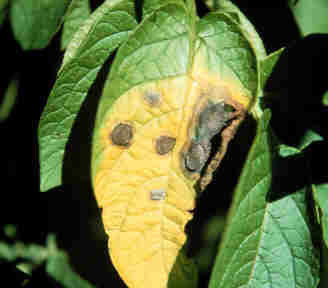Early blight
Scientific name:
Alternaria solani
Causal organism: Fungus
Host plants
The most important hosts are tomato and potato but it will also attack eggplant, pepper, horse nettle, black nightshade, wild cabbage, cucumber, and zinnia.
Affected plant stages
All growth stages
Affected plant parts
Whole plant except the roots
Symptoms
 Photo courtesy of University of Minnesota
Photo courtesy of University of Minnesota
Early blight produces a wide range of symptoms at all growth stages of both potato and tomato which include damping-off, collar rot, stem cankers, leaf blight, and fruit/
tuber rot.
Seedlings grown from infested seeds may damp off soon after emergence because large lesions develop at the ground line on stems of transplants or seedlings. Collar rot occurs when the young stem becomes girdled with dark lesions at the soil level.
The infected leaf has circular lesions of about 1.2 cm (1/2 inch) in diameter. Dark, concentric circles (circles with a common center) are found within these lesions. Infection usually begins on the lower, older leaves and progresses up the plant. Infected leaves eventually wilt, die, and fall off. Early blight lesions show a generally dry "bulls-eye" angular pattern that do not usually spread very far and rarely affect petiole tissue, as the progress of the fungus is stopped by the veins of the leaf.
An infected stem has small, dark, slightly sunken areas that enlarge to form circular or elongated spots with lighter-colored centers. Concentric markings, similar to those on leaves, often develop on
stem lesions.
Infestation during the flowering stage of tomato causes the blossoms to drop. The fruit stems are spotted with lesions that lead to loss of the young fruits.
An infested tomato fruit has dark, leathery sunken spots, usually at the point of the stem attachment. These spots may enlarge to involve the entire upper portion of the fruit, often showing concentric markings like those on leaves. Affected areas may be covered with velvety black masses of spores. Fruits can also be infected during the green or ripe stage through growth cracks and other wounds. Infected fruits often drop before reaching maturity.
An Infested potato tuber has surface lesions that appear a little darker than the adjacent healthy skin. The lesions are usually slightly sunken, circular or irregular, and vary in size up to 1.8 cm (3/4 inch) in diameter. There is usually a well-defined and sometimes slightly raised margin between healthy and diseased
tissues. Examination of internal damage shows a brown to black corky, dry rot, usually not more than 1/4 to 3/8 inch deep and deeper cracks may form in older lesions.
Conditions that favor development
- Infested tomato seeds and potato tubers
- Unhealthy plants
- Plenty of weeds
- Over crowded plants that cause the poor flow of air among the plants
- Too much moisture during cool and warm weather
- Cracked and injured potato tubers
Prevention and control
- Proper selection of seeds and tubers for sowing/planting. Make sure that these are disease-free and not taken from plants that were previously infested by the early blight disease. If possible, use potato and tomato varieties that are resistant to the disease.
- Plow under all the crop residues after harvest to
physically remove the spore source from the topsoil.
- Practice crop rotation. Fields should not be planted with tomato, potato, pepper, or eggplant for at least 2 cropping seasons so that these hosts are not present for the spores to thrive on.
- Remove weeds as these may serve as the alternate hosts.
- Practice the recommended plant spacing to promote good air circulation. Staking tomato plants provides proper aeration to the plants.
- Harvest potato tubers when the soil is not wet and when the vines are dry.
- Minimize injury to the tubers during harvesting and handling.
- Seed treatment

